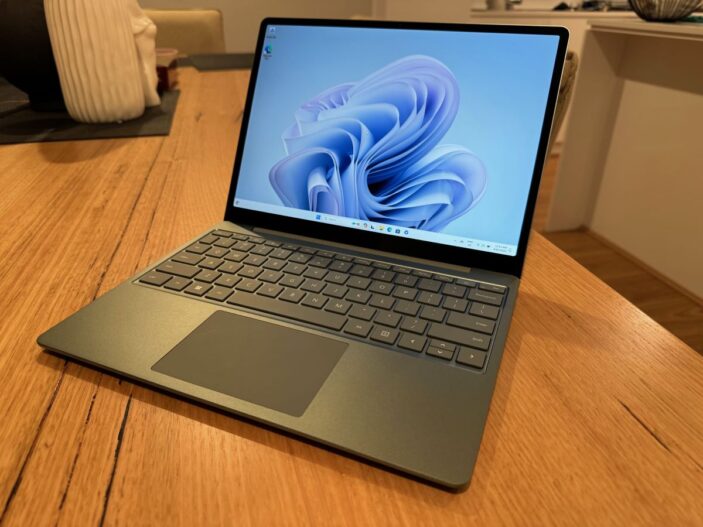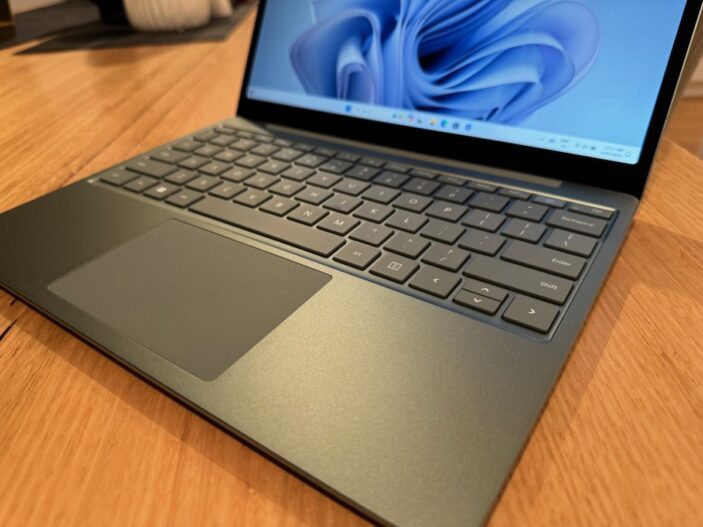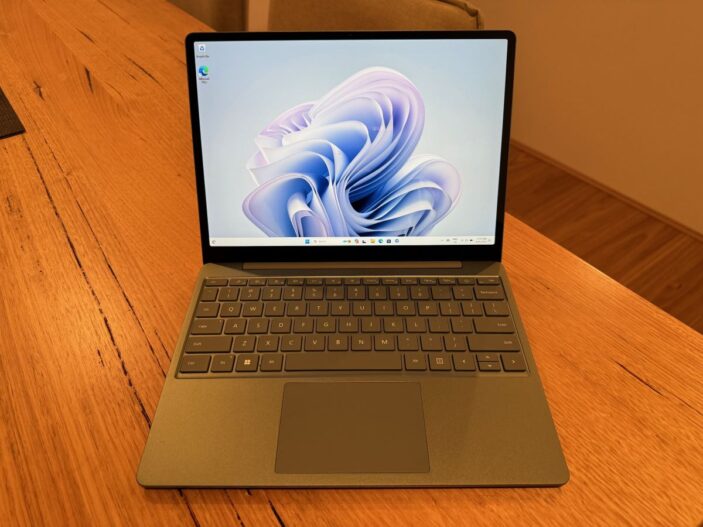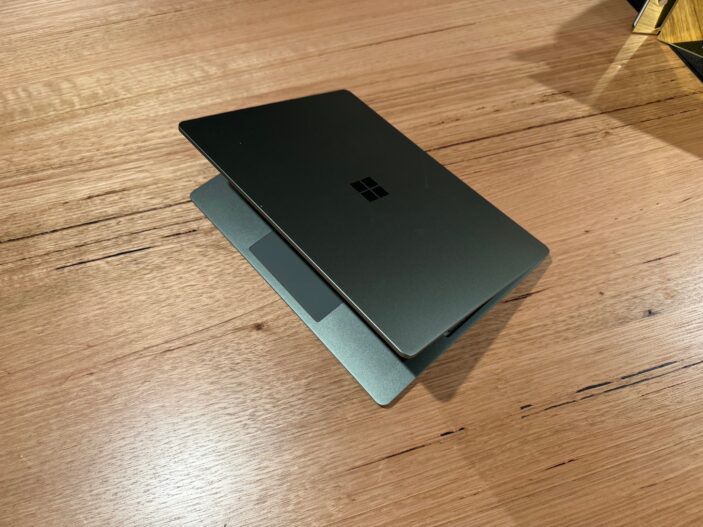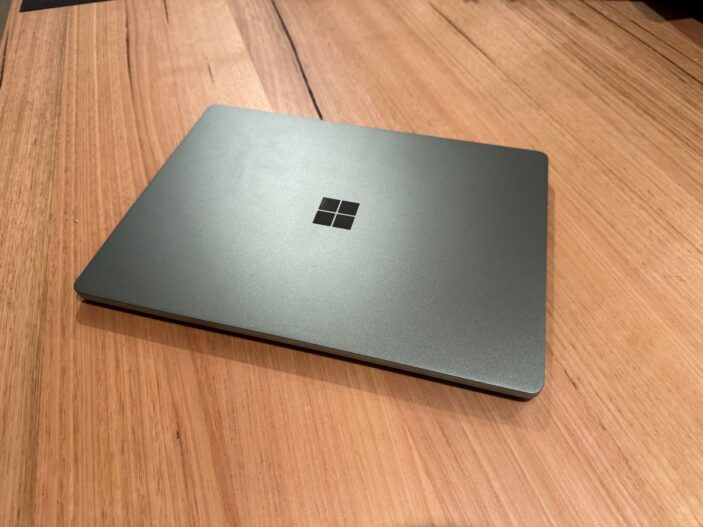I’m all for Microsoft’s Surface range being a great Windows-based alternative for those looking for something either smaller, light or longer-lasting to take out on the go. However, over the years, Microsoft seems focused more so on refining its current range, rather than evolving it. We took a look at the latest Microsoft Surface Laptop Go 3, and while impressive, plays things a little too safe in terms of design and usability, making it hard to recommend for those who have recently purchased a Laptop Go 2. Those who are looking to spend a little more to cater for the overall price increase can certainly find similar specs in likewise third-party models.
Keep in mind, we’re reviewing the version with an Intel i5- 1235U processor, 16GB of RAM and a 256GB SSD.
Design
There are a couple of things to note this time around, but let’s get the basics out of the way. The Surface Laptop Go 3 bears the same weight and dimensions as the Surface Laptop Go 2. That being said, it’s still super slim, making it one of the easiest options on the market as far as portability is concerned. The anodized aluminium frame and finish are gorgeous throughout, while the keyboard is made with a 30% recycled plastic underside.
It now comes in four colours, being Platinum, Sage Green, Ice Blue, and Sandstone. These colours have been around before in the larger standard Surface Laptops, but it’s nice to see the entire range available here. We spent some time with the Sage version, which I had never really been a fan of at a glance, but I cannot deny it has ultimately won me over.
The included fingerprint reader embedded over the power button is a nice touch and works well with very little pressure. I rarely had any issues having to push too hard on the power button, accidentally turning it off or even pressing nearby buttons by mistake.
While they’re on sale regularly, the slight RRP price increase of a couple of hundred bucks feels like a missed opportunity to bolster anything else around and inside of it. Sure, it’s got a USB-C 3.2 port. But it could have made the move to Thunderbolt 4 for those super transfer speeds. It has a 720p HD webcam. But given we’re nearing the price of an M2 MacBook Air with a 1080p HD webcam, there’s certainly room for improvement.
I understand the concept of not fixing what isn’t necessarily broken, but it lacks the ‘wow’ factor that comes with a new lineup of technology. Given the Surface Laptop Go 2 has a lot to love, it would have been nice to see something new this time around.
Display
The 12.4-inch 1,536 x 1,024 display might be just short of full HD, but I stand by the fact that this smaller size screen will rarely convey the difference. It’s the same as the Surface Laptop Go 2 and puts out around 344 nits of peak brightness, which is more than enough for the average indoor user.
The curved corner bezels once again match the overall frame and look incredibly sleek, while Microsoft’s PixelSense technology embedded in the touch display rarely lags or stutters. I never thought the touch screen would come in handy without the 2-in-1 design, but it admittedly has its moments during everyday tasks.
The only real gripe (once again), is that the increased price point is bumping it up into another weight class, so to speak, where it has to contend with similarly priced models like the Lenovo Flex 5i, which comes with a sharper 1080p display, or the Asus Zenbook, which comes with an OLED display for the best possible contrast when viewing media. The M1 MacBook Air even provides its own Liquid Retina display for brighter and more vivid colours for the sake of media and creative productivity when it comes to colour accuracy.
Performance
Thankfully, some of the newer elements of the Surface Laptop Go 3 lie under the hood. The included 12th Gen i5- 1235U processor is decent and has certainly improved battery life when compared to the Surface Laptop Go 2, but we’re also nearing the 14th generation of Intel processors moving into 2024.
The 16GB of DDR5 RAM is a nice improvement over the DDR4 options in the Laptop Go 2, in which the entry-level model came with only 4GB of RAM. Available in either 8GB or 16GB, the increased RAM certainly helps with multitasking, but the overall processing power would be better utilised as an everyday driver for recreation, browsing and occasional streaming. Heavy creative work through apps like Photoshop, Illustrator and Premiere Pro would only be recommended infrequently unless you want to throttle the generally quiet fans and drain the battery much quicker than usual.
Sound is also relatively average, but has been in most options up until this point. The included Omnisonic Speakers with Dolby Audio Premium provide decent mids but lack bass and aren’t really that loud. That being said, I can’t necessarily criticise it for falling in line with almost 90% of other laptops on the market.
It still competes strongly with Lenovo’s similarly priced Flex 5i range and HP’s Pavilion range which provides some great value for money as far as mid-range laptops go. But given the A$1600 tag has now overlapped with the admittedly older yet more efficient M1 MacBook Air, the value could have been stretched a little further in terms of more storage or a beefier processor. Then again, the Laptop Go series has always been touted as a smaller, everyday option for the casual user, so it’s honestly worth weighing up your daily usage.
Battery
The Surface Laptop Go series has always had a decent battery, lasting more than an entire work or school day. Of course, there are always certain steps to take when preserving battery life, like volume, screen brightness and generally usability.
With the screen at 50% brightness, users can expect around 13-14 hours when using it for general streaming and browsing. It’s still ahead of a few options here, only really second to the MacBook range, which pretty much blows the competition out of the water at 22+ hours when used under the same conditions. I promise I’m not an Apple fanboy, but am simply attempting to highlight how this shift in price has brought about comparisons to a new range of similarly priced alternatives.
Verdict & Value
The Microsoft Surface Go Laptop 3 is a solid everyday option that’s incredibly light and long-lasting. The increased RAM doesn’t hurt, and the upgraded 12th Gen Intel processors aren’t bad either in terms of efficiency. But given the price hike, it begs the question; how little is too little?
The Laptop Go 3 might play things safe, as they worked in the Laptop Go 2, but when that same price hike is just enough to put it into a whole new spectrum with new alternatives like the M1 MacBook Air and mid-range Lenovo Flex 5i models, it begs a little more to be desired.
THREE STARS (OUT OF FIVE)
Highlights: Sleek design; Solid build quality; Decent battery life; Option for increased RAM
Lowlights: General price increase puts it up against new competition; Processor lets the upgraded RAM down
Manufacturer: Microsoft
Price: A$1499-$1699 (Depending on model and specifications)
Available: Now
Review based on unit supplied by Microsoft.
More to Explore on the AU:


